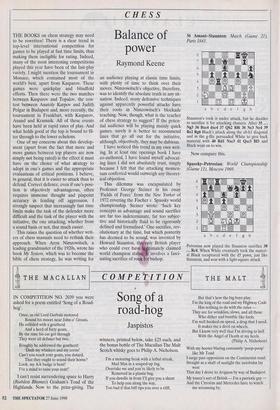CHESS
Balance of power
Raymond Keene
THE BOOKS on chess strategy may need to be rewritten! There is a clear trend in top-level international competition for games to be played at fast time limits, thus making them ineligible for rating. Indeed, many of the most interesting competitions played this year have been of the fast-play variety. I might mention the tournament in Monaco, which contained most of the world's best, apart from Kasparov. These games were quickplay and blindfold efforts. Then there were the two matches between Kasparov and Topalov, the con- test between Anatoly Karpov and Judith Polgar in Budapest and, more recently, the tournament in Frankfurt, with Kasparov, Anand and Kramnik. All of these events have been held at rapid rates of play. And what holds good at the top is bound to fil- ter through to the lower echelons.
One of my concerns about this develop- ment (apart from the fact that more and more games between top players are now simply not being rated) is the effect it must have on the choice of what strategy to adopt in one's games and the appropriate evaluations of critical positions. I believe, in general, that it is easier to attack than to defend. Correct defence, even if one's posi- tion is objectively advantageous, often requires immense thought and pinpoint accuracy in fending off aggression. I strongly suspect that increasingly fast time limits make the task of the defender more difficult and the task of the player with the initiative, the one attacking, whether from a sound basis or not, that much easier.
This raises the question of whether writ- ers of chess manuals need to rethink their approach. When Aron Nimzowitsch, a leading grandmaster of the 1920s, wrote his book My System, which was to become the bible of chess strategy, he was writing for an audience playing at classic time limits, with plenty of time to think over their moves. Nimzowitsch's objective, therefore, was to identify the absolute truth in any sit- uation. indeed, many defensive techniques against apparently powerful attacks have their roots in Nimzowitsch's blockade teaching. Now, though, what is the teacher of chess strategy to suggest? If the poten- tial audience will be playing mainly quick games, surely it is better to recommend lines that go all out for the initiative, although, objectively, they may be dubious.
I have noticed this trend in my own writ- ing. In at least one openings book I have co-authored, I have found myself advocat- ing lines I did not absolutely trust, simply because I felt that the attacking momen- tum conferred would outweigh any theoret- ical objection.
This dilemma was encapsulated by Professor George Steiner in his essay `Fields of Force' from the New Yorker of 1972 covering the Fischer v. Spassky world championship. Steiner wrote: 'Such key concepts as advantage and sound sacrifice are far too indeterminate, far too subjec- tive and historically fluid to be rigorously defined and formalised.' One sacrifice, rev- olutionary at the time, but which posterity has deemed to be sound, was invented by Howard Staunton, th rely British player who could ever have limately claimed world champion status involves a fasci- nating sacrifice of rook for bishop. St Amant—Staunton: Match (Game 21), Paris 1843.
Staunton's rook is under attack, but he decides to sacrifice it for attacking chances. After 35 Ng3 36 Bxc4 dxc4 37 Qb2 Rf6 38 Ne4 39 Reg Itg6 Black's attack along the a8-hl diagonal and in the g-file persuaded White to give back and Black with 40 Rdl Nxc3 41 Qxc3 Bf3 d Black went on to win.
Now compare this.
Spassky—Petrosian: World Championship (Game 11), Moscow 1969.
Petrosian now played the Staunton sacrifice 30 ...Rc4. When White eventually took the materi- al Black recaptured with the d5 pawn, just like Staunton, and won with a light-square attack.


























































 Previous page
Previous page